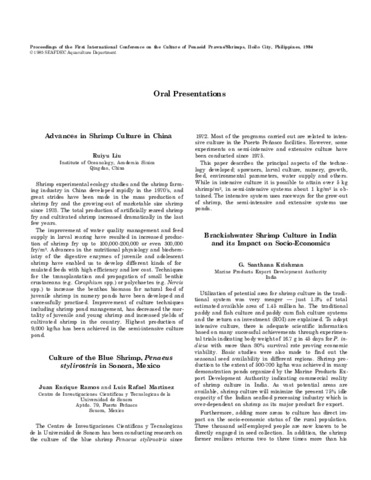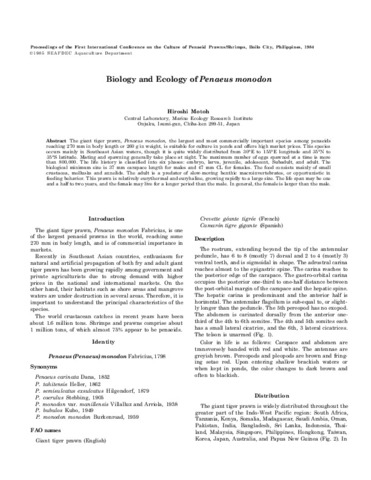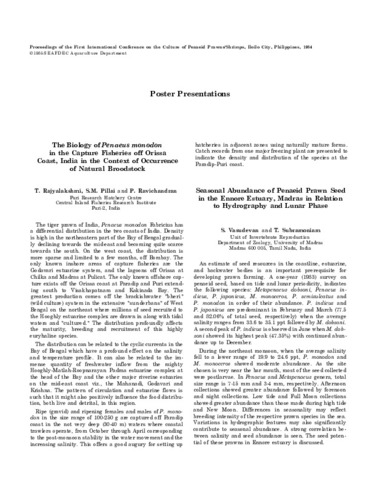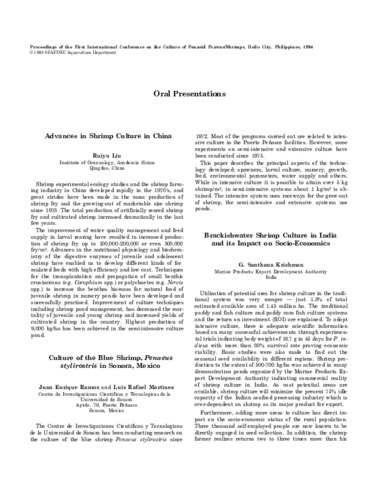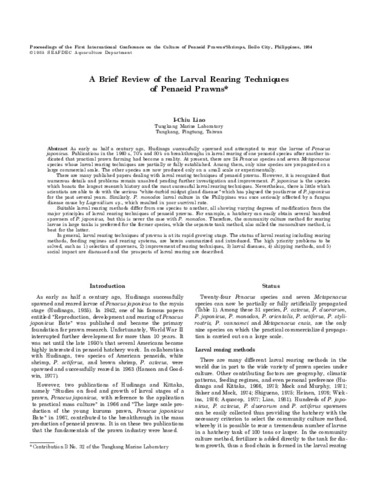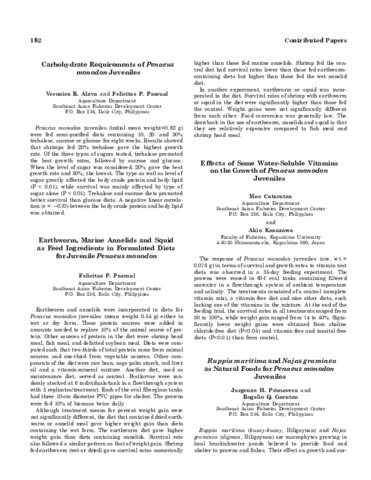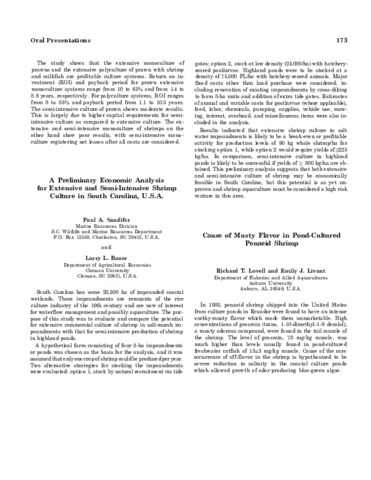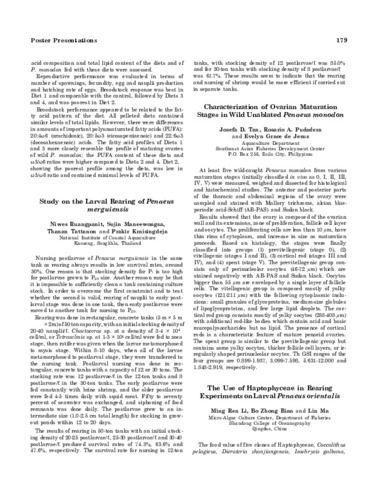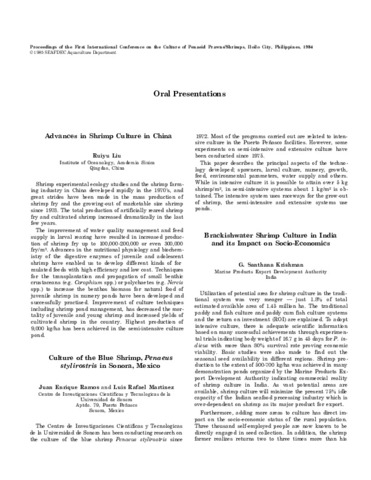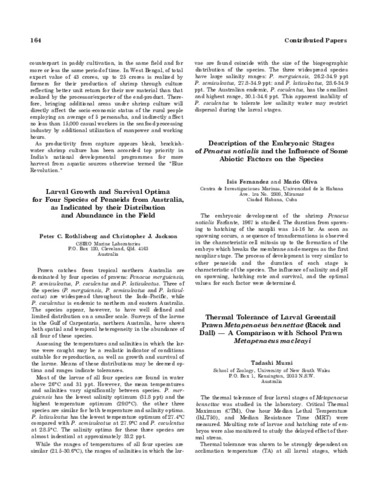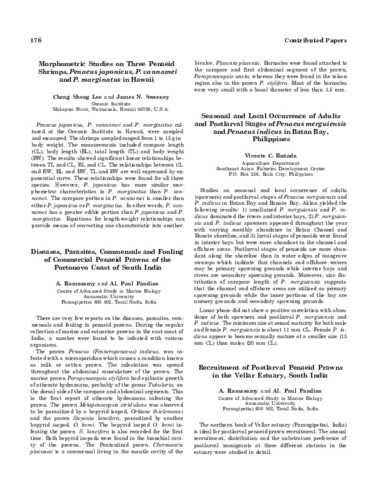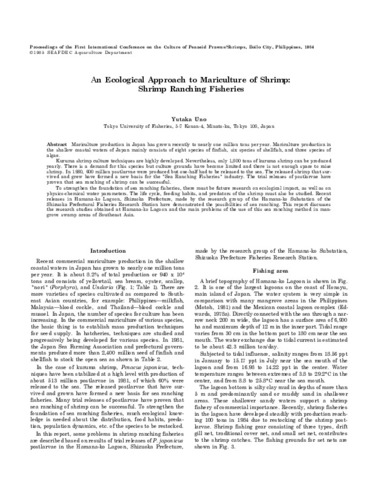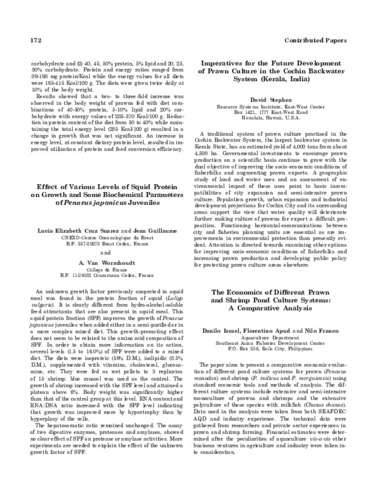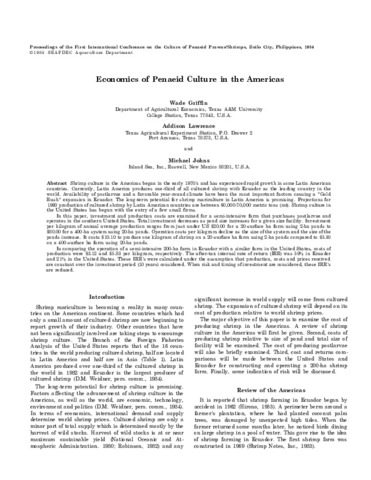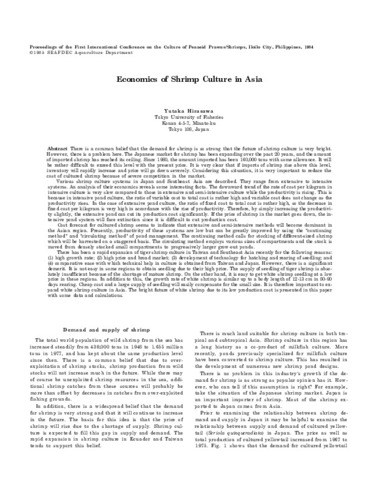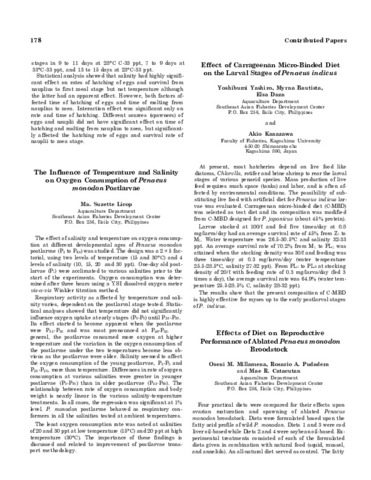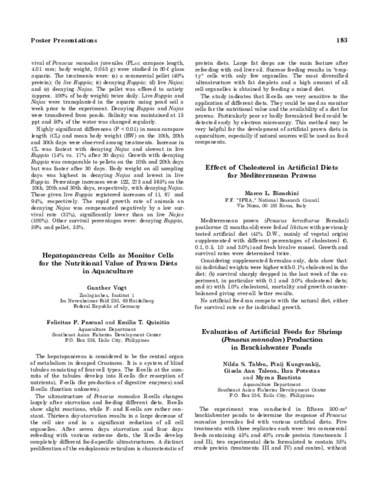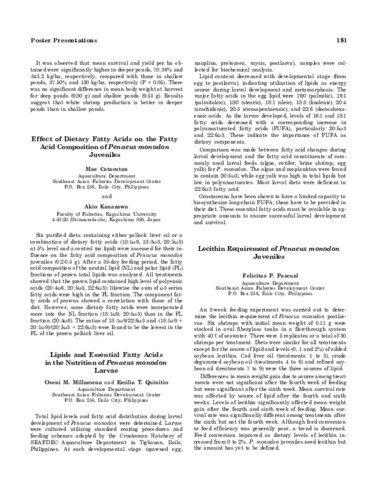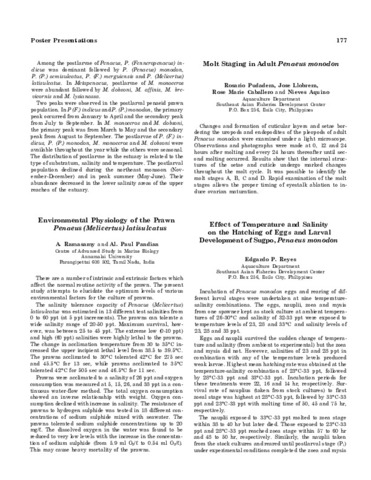Browsing Proceedings of the First International Conference on the Culture of Penaeid Prawns/Shrimps by Title
Now showing items 1-20 of 79
-
Advances in shrimp culture in China
(Aquaculture Department, Southeast Asian Fisheries Development Center, 1985)Shrimp experimental ecology studies and the shrimp farming industry in China developed rapidly in the 1970's, and great strides have been made in the mass production of shrimp fry and the growing-out of marketable size ... -
Biology and ecology of Penaeus monodon
(Aquaculture Department, Southeast Asian Fisheries Development Center, 1985)The giant tiger prawn, Penaeus monodon, the largest and most commercially important species among penaeids reaching 270 mm in body length or 260 g in weight, is suitable for culture in ponds and offers high market prices. ... -
The biology of Penaeus monodon in the capture fisheries off orissa coast, India in the context of occurrence of natural broodstock
(Aquaculture Department, Southeast Asian Fisheries Development Center, 1985)The tiger prawn of India, Penaeus monodon Fabricius has a differential distribution in the two coasts of India. Density is high in the northeastern part of the Bay of Bengal gradually declining towards the mid-east and ... -
Brackishwater shrimp culture in India and its impact on socio-economics
(Aquaculture Department, Southeast Asian Fisheries Development Center, 1985)Utilization of potential area for shrimp culture in the traditional system was very meager — just 1.8% of total estimated available area of 1.45 million ha. The traditional paddy and fish culture and paddy cum fish culture ... -
A brief review of the larval rearing techniques of penaeid prawns
(Aquaculture Department, Southeast Asian Fisheries Development Center, 1985)As early as half a century ago, Hudinaga successfully spawned and attempted to rear the larvae of Penaeus japonicus. Publications in the 1960 s, 70's and 80's on breakthroughs in larval rearing of one penaeid species after ... -
Carbohydrate requirements of Penaeus monodon juveniles
(Aquaculture Department, Southeast Asian Fisheries Development Center, 1985)Penaeus monodon juveniles (initial mean weight=0.62 g) were fed semi-purified diets containing 10, 20 and 30% trehalose, sucrose or glucose for eight weeks. Results showed that shrimps fed 20% trehalose gave the highest ... -
Cause of musty flavor in pond-cultured penaeid shrimp
(Aquaculture Department, Southeast Asian Fisheries Development Center, 1985)In 1983, penaeid shrimp shipped into the United States from culture ponds in Ecuador were found to have an intense earthy-musty flavor which made them unmarketable. High concentrations of geosmin (trans, 1-10-dimethyl-1-9 ... -
Characterization of ovarian maturation stages in wild unablated Penaeus monodon
(Aquaculture Department, Southeast Asian Fisheries Development Center, 1985)At least five wild-caught Penaeus monodon from various maturation stages (initially classified in vivo as 0, I, II, III, IV, V) were measured, weighed and dissected for histological and histochemical studies. The anterior ... -
Culture of blue shrimp, Penaeus stylirostris in Sonora, Mexico
(Aquaculture Department, Southeast Asian Fisheries Development Center, 1985)The Centro de Investigaciones Cientificas y Tecnologicas de la Universidad de Sonora has been conducting research on the culture of the blue shrimp Penaeus stylirostris since 1972. Most of the programs carried out are ... -
Description of the embryonic stages of Penaeus notialis and the influence of some abiotic factors on the species
(Aquaculture Department, Southeast Asian Fisheries Development Center, 1985)The embryonic development of the shrimp Penaeus notialis Farfante, 1967 is studied. The duration from spawning to hatching of the nauplii was 14-16 hr. As soon as spawning occurs, a sequence of transformations is observed ... -
Diseases, parasites, commensals and fouling of commercial Penaeid prawns of the Portonovo coast of South India
(Aquaculture Department, Southeast Asian Fisheries Development Center, 1985)There are very few reports on the diseases, parasites, commensals and fouling in penaeid prawns. During the regular collection of marine and estuarine prawns in the east coast of India, a number were found to be infested ... -
Earthworm, marine annelids and squid as feed ingredients in formulated diets for juvenile Penaeus monodon
(Aquaculture Department, Southeast Asian Fisheries Development Center, 1985)Earthworm and annelids were incorporated in diets for Penaeus monodon juveniles (mean weight 0.54 g) either in wet or dry form. These protein sources were added in amounts needed to replace 10% of the animal source of ... -
An ecological approach to mariculture of shrimp: Shrimp ranching fisheries
(Aquaculture Department, Southeast Asian Fisheries Development Center, 1985)Mariculture production in Japan has grown recently to nearly one million tons per year. Mariculture production in the shallow coastal waters of Japan mainly consists of eight species of finfish, six species of shellfish, ... -
The economics of different prawn and shrimp pond culture systems: A comparative analysis
(Aquaculture Department, Southeast Asian Fisheries Development Center, 1985)The paper aims to present a comparative economic evaluation of different pond culture systems for prawn (Penaeus monodon) and shrimp (P. indicus and P. merguiensis) using standard economic tools and methods of analysis. ... -
Economics of penaeid culture in the Americas
(Aquaculture Department, Southeast Asian Fisheries Development Center, 1985)Shrimp culture in the Americas began in the early 1970's and has experienced rapid growth in some Latin American countries. Currently, Latin America produces one-third of all cultured shrimp with Ecuador as the leading ... -
Economics of shrimp culture in Asia
(Aquaculture Department, Southeast Asian Fisheries Development Center, 1985)There is a common belief that the demand for shrimp is so strong that the future of shrimp culture is very bright. However, there is a problem here. The Japanese market for shrimp has been expanding over the past 20 years, ... -
Effect of carrageenan micro-binded diet on the larval stages of Penaeus indicus
(Aquaculture Department, Southeast Asian Fisheries Development Center, 1985)At present, most hatcheries depend on live food like diatoms, Chlorella, rotifer and brine shrimp to rear the larval stages of various penaeid species. Mass production of live feed requires much space (tanks) and labor, ... -
Effect of cholesterol in artificial diets for Mediterranean prawns
(Aquaculture Department, Southeast Asian Fisheries Development Center, 1985)Mediterranean prawn (Penaeus kerathurus Forsskal) postlarvae (2 months old) were fed ad libitum with previously tested artificial diet (41% D.W., mainly of vegetal origin) supplemented with different percentages of cholesterol ... -
Effect of dietary fatty acids on the fatty acid composition of Penaeus monodon juveniles
(Aquaculture Department, Southeast Asian Fisheries Development Center, 1985)Six purified diets containing either pollack liver oil or a combination of dietary fatty acids (18:1ω9, 18:3ω3, 20:5ω3) at 5% level and a control (no lipid) were assessed for their influence on the fatty acid composition ... -
Effect of temperature and salinity on the hatching of eggs and larval development of sugpo, Penaeus monodon
(Aquaculture Department, Southeast Asian Fisheries Development Center, 1985)Incubation of Penaeus monodon eggs and rearing of different larval stages were undertaken at nine temperature-salinity combinations. The eggs, nauplii, zoea and mysis from one spawner kept as stock culture at ambient ...

